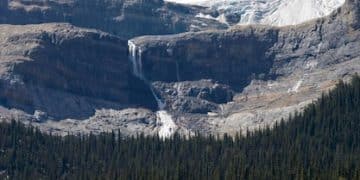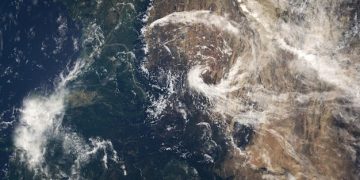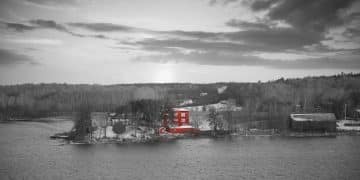Climate Change and Wildfires: Understanding the Risks in the US
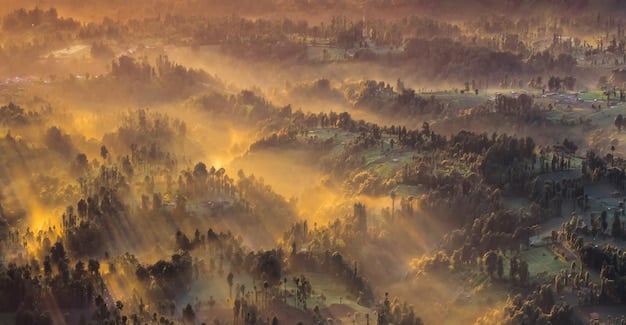
Climate change significantly exacerbates wildfire risk in the US by increasing temperatures, prolonging droughts, and creating drier conditions, challenging current wildfire management strategies and necessitating innovative approaches for prevention and response.
The escalating threat of wildfires in the United States is becoming increasingly intertwined with the impacts of climate change. Understanding how is climate change affecting wildfire risk and management in the US is crucial for protecting communities, ecosystems, and economies.
Understanding the Climate Change-Wildfire Connection
Climate change acts as a threat multiplier, intensifying existing wildfire risks and creating new challenges for resource managers. Increased temperatures, altered precipitation patterns, and more frequent droughts contribute to drier vegetation and longer fire seasons.
These conditions create a landscape ripe for ignition and rapid fire spread. To fully grasp the urgency of the situation, it’s essential to understand the multifaceted ways in which climate change influences wildfire behavior.
Rising Temperatures and Drier Conditions
One of the most direct links between climate change and wildfires is the increase in average temperatures. Higher temperatures lead to increased evaporation, drying out vegetation and soil. This creates a more flammable environment.
Warmer temperatures also extend the period during which vegetation is dry enough to burn, effectively lengthening the fire season. This means that fire-prone regions are at risk for more months of the year.
Changes in Precipitation Patterns
Climate change is also altering precipitation patterns, leading to more prolonged and intense droughts in many regions. These droughts further exacerbate the dryness of vegetation, making it easier to ignite.
In addition, changes in precipitation can affect the type and amount of vegetation that grows in an area. Shifts in plant communities can create conditions that are more conducive to fire spread.
- Increased temperatures leading to drier vegetation.
- Prolonged droughts exacerbating flammability.
- Altered precipitation patterns affecting plant communities.
- Longer fire seasons increasing overall risk.
In conclusion, the connection between climate change and wildfires is undeniable. Rising temperatures, drier conditions, and altered precipitation patterns all contribute to increased wildfire risk. These changes pose significant challenges for wildfire management in the US.
Assessing Wildfire Risk: Key Factors and Indicators
Effective wildfire management relies on accurate risk assessment. This involves understanding the key factors that contribute to wildfire ignition and spread, as well as monitoring indicators that can signal increased risk.
By carefully assessing these factors and indicators, resource managers can make informed decisions about prevention and suppression efforts. These efforts are vital for protecting communities and ecosystems.
Fuel Load and Vegetation Type
The amount and type of vegetation in an area, known as the fuel load, is a primary determinant of wildfire risk. Densely forested areas with dry underbrush are particularly susceptible to large, intense fires.
Different types of vegetation have different flammability characteristics. For example, grasslands can ignite easily and spread fire rapidly, while dense forests may burn more slowly but with greater intensity.
Climate and Weather Conditions
Climate and weather conditions play a crucial role in determining wildfire risk. Hot, dry, and windy conditions are particularly conducive to fire ignition and spread.
Factors such as temperature, humidity, wind speed, and precipitation all influence the moisture content of vegetation and the rate at which fire spreads.

- Fuel load: Amount and type of vegetation.
- Climate: Long-term weather patterns.
- Weather: Short-term atmospheric conditions.
- Ignition sources: Natural and human-caused factors.
Overall, assessing wildfire risk requires a comprehensive understanding of fuel load, climate, weather conditions, and ignition sources. By carefully monitoring these factors, resource managers can better prepare for and respond to wildfire events.
The Impact of Wildfires on US Ecosystems and Communities
Wildfires have profound impacts on both ecosystems and communities across the United States. These impacts range from ecological changes to economic losses and public health concerns.
By understanding the full extent of these impacts, we can better appreciate the importance of effective wildfire management. This understanding can inform strategies for mitigating the negative consequences of wildfires.
Ecological Effects
Wildfires can have both positive and negative effects on ecosystems. In some ecosystems, fire is a natural process that helps maintain biodiversity and promote healthy growth.
However, increasingly frequent and intense wildfires can overwhelm ecosystems, leading to long-term damage. This includes loss of habitat, soil erosion, and changes in plant and animal communities.
Community Impacts
Wildfires pose significant risks to communities, particularly those located in the wildland-urban interface. These are areas where homes and other structures are built in or near wildland vegetation.
Wildfires can destroy homes and businesses, disrupt infrastructure, and lead to evacuations. In addition, smoke from wildfires can cause respiratory problems and other health issues.
- Ecosystems: Habitat loss, soil erosion, biodiversity changes.
- Communities: Property damage, health impacts, economic losses.
- Air Quality: Smoke and particulate matter pollution.
- Infrastructure: Damage to power lines, roads, and water systems.
In summary, wildfires have wide-ranging impacts on ecosystems and communities in the US. From ecological changes to economic losses and public health concerns, the consequences of wildfires are significant and far-reaching.
Current Wildfire Management Strategies in the US
Wildfire management in the US involves a range of strategies aimed at preventing, suppressing, and mitigating the impacts of wildfires. These strategies include prescribed burns, fuel reduction projects, and rapid response efforts.
However, the increasing frequency and intensity of wildfires are challenging the effectiveness of these traditional approaches. Innovation and adaptation are becoming increasingly important for protecting communities and resources.
Prescribed Burns and Fuel Reduction
Prescribed burns, also known as controlled burns, are intentionally set fires used to reduce fuel loads and prevent larger, more destructive wildfires. They are carefully planned and monitored to minimize risks.
Fuel reduction projects involve removing or modifying vegetation to reduce the amount of flammable material available to burn. This can include thinning forests, clearing underbrush, and creating firebreaks.
Suppression and Response
Wildfire suppression involves efforts to extinguish or contain wildfires as quickly as possible. This includes using firefighters, aircraft, and other resources to control the spread of flames.
Rapid response efforts are critical for preventing small fires from growing into large, uncontrollable events. These efforts rely on early detection and quick deployment of resources.
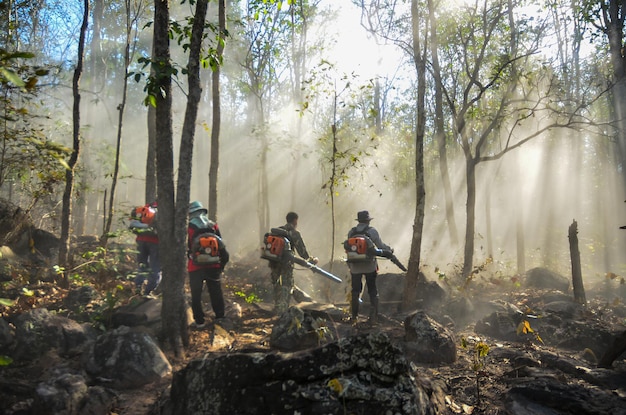
- Prescribed burns: Controlled fires to reduce fuel.
- Fuel reduction: Removing flammable vegetation.
- Suppression: Extinguishing active wildfires.
- Rapid response: Quick deployment to contain fires.
In conclusion, current wildfire management strategies in the US include a combination of prevention, suppression, and mitigation efforts. However, the increasing challenges posed by climate change necessitate innovative approaches and adaptation to changing conditions.
Adapting Wildfire Management to a Changing Climate
Adapting wildfire management to a changing climate requires a shift in strategies, with a greater emphasis on prevention, resilience, and community engagement. This includes investing in research, developing new technologies, and promoting fire-adapted communities.
By embracing these approaches, we can better protect our communities and ecosystems from the increasing threat of wildfires. This is essential for ensuring a sustainable future in a changing climate.
Investing in Research and Technology
Increased investment in research and technology is crucial for understanding the complex interactions between climate change and wildfires. This includes developing new models to predict fire behavior and assess risk.
New technologies, such as drones and satellite imagery, can also improve early detection and monitoring of wildfires. These tools can help resource managers make more informed decisions about resource allocation and suppression efforts.
Building Fire-Adapted Communities
Building fire-adapted communities involves educating residents about wildfire risks and promoting practices that reduce vulnerability. This includes creating defensible space around homes, using fire-resistant building materials, and developing evacuation plans.
Community engagement is essential for fostering a culture of preparedness and resilience. By working together, communities can better protect themselves from the impacts of wildfires.
- Research: Understanding climate-wildfire interactions.
- Technology: Improving detection and monitoring.
- Community engagement: Promoting preparedness and resilience.
- Policy Changes: Implementing better land management practices.
In short, adapting wildfire management to a changing climate requires a multifaceted approach that includes research, technology, community engagement, and policy changes. By embracing these strategies, we can better protect our communities and ecosystems from the increasing threat of wildfires.
Future Outlook: Projections and Potential Solutions
Looking ahead, projections indicate that wildfire risk in the US will continue to increase as climate change intensifies. This underscores the urgent need for proactive measures and innovative solutions.
By investing in research, technology, and community engagement, we can develop more effective strategies for managing wildfires and mitigating their impacts. This is essential for ensuring a sustainable future in a changing climate.
Projections for Increased Wildfire Risk
Climate models predict that many regions of the US will experience longer fire seasons, more frequent droughts, and higher temperatures in the coming decades. These changes will create conditions that are even more conducive to wildfire ignition and spread.
Some studies suggest that the area burned by wildfires could double or even triple by the end of the century if current trends continue. This would have significant consequences for ecosystems, communities, and economies.
Potential Solutions and Innovations
Despite the challenges, there are many potential solutions and innovations that could help mitigate the impacts of wildfires. This includes developing more fire-resistant building materials, improving early detection systems, and promoting more sustainable land management practices.
In addition, advances in artificial intelligence and machine learning could help resource managers make more informed decisions about resource allocation and suppression efforts. These technologies could also be used to develop more sophisticated wildfire risk models.
- Increased wildfire frequency.
- Longer fire seasons.
- Expansion of fire-prone areas.
- Need for proactive measures and innovation.
In conclusion, the future outlook for wildfire risk in the US is concerning, but there are also reasons for optimism. By investing in research, technology, and community engagement, we can develop more effective strategies for managing wildfires and ensuring a sustainable future.
| Key Point | Brief Description |
|---|---|
| 🔥 Increased Temperatures | Higher temperatures cause drier vegetation, increasing fire risk. |
| 🌧️ Altered Precipitation | Changes in rainfall lead to prolonged droughts, exacerbating fire conditions. |
| 🌲 Fuel Reduction | Strategies like prescribed burns reduce flammable vegetation, minimizing fire spread. |
| 🏘️ Community Engagement | Educating and involving communities enhances preparedness and resilience to wildfires. |
▼
Climate change raises temperatures and alters precipitation, leading to drier vegetation. This creates conditions more prone to ignition and rapid fire spread, increasing overall wildfire risk.
▼
Key factors include fuel load (amount of vegetation), climate conditions (temperature, humidity), weather patterns (wind, precipitation), and ignition sources (lightning, human activity).
▼
Strategies involve prescribed burns (controlled fires), fuel reduction projects (vegetation removal), and suppression efforts (firefighting resources). Rapid response is critical to contain fires quickly.
▼
Communities can create defensible space around homes, use fire-resistant building materials, develop evacuation plans, and participate in community engagement initiatives to increase preparedness.
▼
Projections indicate increased wildfire frequency and intensity due to climate change. Proactive measures and innovative solutions are crucial to mitigate impacts and ensure a sustainable future.
Conclusion
In conclusion, the interplay between climate change and wildfire dynamics in the US presents a complex and growing challenge. Rising temperatures, altered precipitation patterns, and increased fuel loads are exacerbating wildfire risk, necessitating adaptive management strategies. By integrating research, technology, and community engagement, and policy changes, we can strive toward a more resilient and sustainable future amidst the escalating threat of wildfires.

